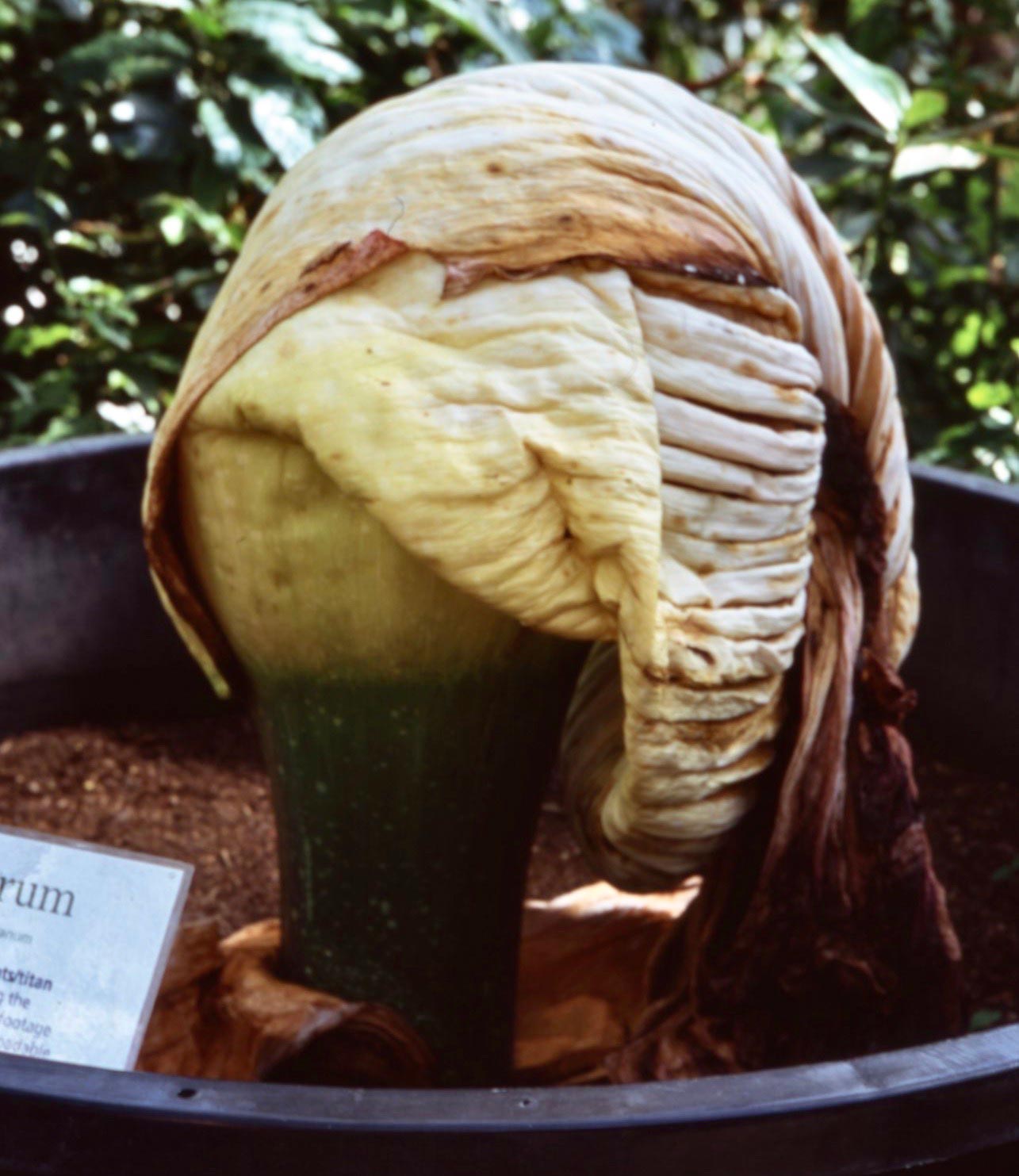This afternoon I scanned a few more recently rediscovered colour slides from August 2008. These are from a visit to Kew Gardens.



Beside the lake huge gunnera grow; upon it plays a splendid fountain.


The Titan Arum, or Amorphophallus Titanum, otherwise, on account of its putrid pong, known as the corpse plant, a native of Sumatra, is grown in the tropical hothouse. My second image bears a loose resemblance to the unfortunate hooded Elephant Man of Victorian England.
Later, I received a text inviting me to book an appointment for a Covid vaccine at our own surgery in Milford on Sea. This has to be done on line. If I don’t do it I will receive a phone call next week. Having already been offered and booked one in Christchurch I tried to telephone to discuss this. It was, of course, not possible. It looks as if I will take the bird in the hand.
With two more chapters of ‘Little Dorrit’ read, I scanned two more of Charles Keeping’s inimitable illustrations.
First we have ‘It became necessary to lead Mr F’s Aunt from the room’, which offers three different, accurate portraits.
‘Past homeless people lying coiled up in nooks’ depicts a social ill which to some lesser extent is still with us, as demonstrated by this East End Review article of April 15th 2015:
‘The homeless person sleeping rough might be a common image in London today, but in the 19th century there were hundreds spilling onto the streets every night.
Short but powerful, the new exhibition Homes of the Homeless: Seeking Shelter in Victorian London at the Geffrye Museum seeks to illuminate the daily struggle of the bitterly poor in the city 200 years ago. What this exhibition highlights most candidly is the juxtaposition between the Victorian ideal of the home and the reality of destitution in this period.
Some took to sleeping in London’s parks, while others tumbled into shelters and workhouses, where conditions varied massively. Queueing for accommodation was something frequently seen on the streets come dark, even in central locations like Covent Garden, and protests broke out as hundreds camped out in Trafalgar Square.

Touching in so many different ways, the exhibition features paintings, photographs, testimonials and engravings all depicting homelessness in its various guises. The destitute family was a common image, with children evoking particular sympathy, and billboards and newspapers both carried adverts imploring people to give whatever they could to support the city’s more unfortunate souls. The government did, by today’s standards, much to stem the flow of homelessness in the capital, but as the century progressed, the problem became more difficult to contain.
Homes of the Homeless charts this challenge, touching on the different approaches to homelessness – from casual wards where ‘inmates’ could exchange hard labour for a place to sleep, to model lodging houses that were designed to more closely imitate a real home – as well as real people’s reactions to their dire circumstances, collected from investigative journalism and charity reports.
Thoroughly researched and straightforwardly presented, this exhibition is accessible to anyone interested in the history of London. With glaring relevance today, it presents a significant slice of history that should not be overlooked, and an important lesson in charity and compassion. Homes of the Homeless is a succinct, enlightening exhibition in one of London’s most charming museums.’
This evening we dined on Jackie’s wholesome chicken and vegetable stewp with crusty bread, with which I drank more of the Macon.


What is stewp?
Becky should know – it’s what she and Mat called thick soup/stew. Thanks a lot
Heart-rending details of the plight of homeless people. We have many of them on our streets, especially during winter months, when they tend to gravitate to warmer climes. I have observed them “coiled up in nooks,” yet not en masse, as portrayed by Keeping’s emotionally wrenching illustration.
Thank you very much, Dolly. Keeping was a Londoner himself
You are very welcome, Derrick.
The poverty and plight of the homeless is indeed a social ill that is still with us. That exhibition must have been intense.
Thanks very much, Merril
Let’s know about the vaccine, which one and your affects days after. I’ll be very interested in side affects. 🙂
OK. Thanks a lot, Chrissy
Your header scan, about life under the London Bridge is decriptively superb Derrick…
Isn’t it, Ivor? Thanks very much
Packed post this evening Derrick. It’s sobering to realise that so little progress has been since Victorian times!
Yes. Thanks a lot, Sheree
I was responsible for Homeless services when working for the Council. I can confirm that it is all rather depressing.
Thanks very much, Andrew
Wonderful photos of a beautiful garden and extraordinary plants.
I’m sure that so many are looking forward to such gardens being properly open again..!
The very complex plight of the homeless is, indeed,still with us.
And so is the plight of those living in ‘homes’, but without what would be considered basic necessities.
The pained faces in your final image, particularly, say so much.
Thank you very much for your appreciation, Emma.
Ian asked my question about stewp! I like that word!
Thick soup with lots of bits in it 🙂 Thanks a lot, Leslie
Love the painting by Thomas Benjamin Kennington. Homelessness has become a critical situation here in the City of Los Angeles.
Thanks very much, Rosaliene. It looks as if the virus hasn’t helped
It sure hasn’t.
I enjoyed the photos from Kew Gardens!
Homelessness is on the rise here as well. It is indeed a complex issue with many roots. Covid and politics tipped the balance for many.
Yes, indeed, Lavinia. Thank you very much.
It’s been a rough day here. The oldest cat suddenly died in his sleep, curled up in his cardboard box hangout. I found him after lunch, buried him this afternoon. No joy here tonight.
Very sorry for you both XX
Thank you for opening our eyes and our hearts with these personal glimpses into homelessness. When we look into the eyes of people and learn a little bit about their stories, compassion grows. That is what we need – compassion and creative strategies. I can only hope that we make progress to a better future.
So true, JoAnna. Thank you very much
I thought the Elephant Man too, Derrick. Sadly, homelessness is a global issue that needs to be addressed. It’s heartbreaking.
It is, indeed, Jill. During my childhood we were never homeless, but rent was such a priority that my parents really struggled with everything else. Thanks very much
Interesting pictures of the past both of the ones you captured and those of the past.
Thank you very much, Mrs W
Your discussion of the plight of the homeless in Victorian times gave me pause. I depend so much on my home for my mental well-being, as well as shelter, that I can’t imagine the horror of being homeless. And so many people are in that situation.
Indeed, Liz. The worst part of it is that there seems no way out. Thanks very much
You’re welcome, Derrick. You’re right about there seemingly being no way out. It is confounding that in the twenty-first century, developed countries can’t find a way to ensure that all citizens have a place to live.
I wish some of the more hard-hearted Republicans in this country would take to heart the lessons of Homes of the Homeless.
I’m sure, Laurie. Thanks very much
A sobering reminder of the dire situation of the homeless – of which there are many in this country – rendered worse (and spread wider) by the economic effects of this pandemic. It is sad to read of ordinary families who contributed to the economy now sans jobs, unable to pay school fees, and no longer able to even live in the homes they have not finished paying for.
Yes, Anne, so terribly wrong. Thanks very much
Poverty will remain a permanent riddle to the economists and social scientists of the world. While the third world and worse countries in the world are witnessing a widening of the chasm between the haves and the have-nots, even the developed world has had its share of homelessness and destitution. I reckon the naked selfishness of a handful of people often disguised as politicians and rulers of the masses, combined with a handful of commercially successful giants, not to speak of the corrupt, are the chief ingredient of this phenomenon.
Thank you so much, Uma, for this sound analysis
The pictures were really nice
Thank you very much, Mrinalini
Beautiful photos. And that painting touches the heart deeply.
It’s sad that people ever had to live on the street anywhere, anytime. And that it still happens today is very sad.
For many decades, my family and I have gotten involved in many volunteer projects to help the homeless. It has been very rewarding emotionally…and we’ve learned a lot from so many of these precious people.
Thank you for sharing such an important post, Derrick.
(((HUGS)))
And thank you for reading and appreciating it, Carolyn X
I was surprised to find that people would pay money to fall asleep on a rope, forty or so at a time, all in the one room. Apparently, one of Jack the Ripper’s victims had just left one of these establishments.
I didn’t know about that, John. Thanks very much.
Illuminating post, Derrick. I would like to have seen the 2015 exhibition. On a happier note, The gunnera was in a good setting next to the fountain in terms of visual similarity (Kew Gardens).
I am pleased you will be getting your jab soon.
Thank you very much, Helen
?
Good news about the vaccination. In Nottingham we have a vaccine shortage while you have a choice of two. Makes you wonder how these things are organised, doesn’t it?
It does indeed. My 73 year old sister in Lincolnshire has already had hers. Thanks very much, Quercus
Good to know that it’s getting done. Looks like they are starting at the edges and working towards the middle.
Lovely memories from Kew Gardens and good news about vaccination.
Thanks very much, Rupali
It is so easy to become homeless We were for a while many decades ago. Still not enough is done to help the homeless.
Thanks very much, Sherry
Here, mental illness and drug abuse exacerbate the problems. There’s also the odd (to me) phenomenon of the preference of many for life on the streets. Since Covid, sudden poverty has become a prime contributor, but it’s not the only one. I’d love to see the exhibit you mentioned; the painting you highlighted brought to mind a rather different Manet.
Thanks very much, Linda. You are right, some do prefer life on the streets, but for most it is not a matter of choice, Thanks for the Manet link. I didn’t know that one.
I love the picture of the mom and children on Trafalgar Square. Good for you for taking the “bird in hand” and getting the vaccine appointment. Bob & I have both had shot #1 – waiting now for the second one. I hope your experience does not include long waiting in long lines like they experienced in CA this week.
Our appointments are timed, so we should be OK, Jan. Thanks very much
What awful thoughts that we might return to 19th century conditions where so many have to live on the streets. I suppose some of my convict ancestors might have been in just these conditions. Lucky they escaped to Australia. I like that the exhibition is showing the public this.
Thank you very much, Amanda. That is such a good point about your ancestors, and good for them that they made it over.
Indeed. My seventh great grandfather did much much better here than they would have on the streets of London.
Great memories! Homeless I guess unfortunately will always be a problem ?
Yes, I think so, Ribana. Thanks very much
Thanks for thhis
Thanks very much, Tara